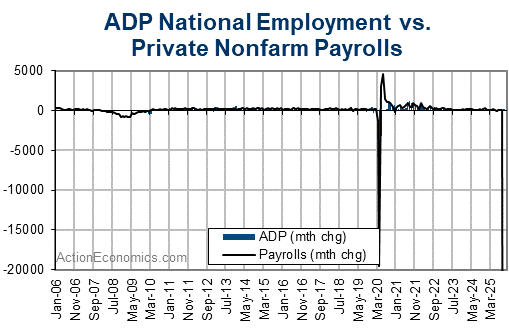US May payroll report in focus today:
The markets are braced for a surge in the unemployment rate to a record high. The markets are forecasting a 17.4% print, up from 14.7%. With other data, especially claims and PMI labor numbers, indicating job losses are moderating, today’s data could be the peak. Ere non-farm payrolls are expected to fall from -2.000 mln to -8.000mln, with a huge gap between several research houses, but definetely a significant moderate versus the unreal -20.537 min plunge in April. Hourly earnings should drop 1.0% versus the government payment induced 4.7% rise in April.

The -2,000k nonfarm payroll forecast assumes a -2,100k private jobs decrease. The assumed drop across industries has been distributed, though given the May bounces in many measures of activity outside of the claims data, in which we could presumably see gains for some components. The goods based employment drop is pegged at -500k, after a -2,355k drop in March. Construction employment is seen falling -70k, after a -975k decline in April and a 33k decrease in March, while factory jobs fall -400k, after a -1,330k April decrease and a -34k decline in March. The private service job has been estimated to decline of -1,601k in May, after a -17,202k drop in April, while a 100k government employment rise is anticipated that is boosted by Census hiring and some reversal of the April plunge in education employment, though the seasonal factors assume that these annual exits are partly in May-June but mostly in July.
Hourly Earnings
One of the most important component in today’s job report is the hourly earnings. A -1.0% decrease is anticipated in May for average hourly earnings, after gains of 4.7% in April, 0.5% in March, and 0.3% in February. Job losses have been skewed toward lower paid retail and leisure and hospitality workers, and this prompted the May spike in average hourly earnings. Market’s forecasts suggest a 6.6% y/y increase in May from 7.9% in April, 3.3% in March, and 3.0% February. Growth in hourly earnings was gradually climbing from the 2% trough area between 2010 and 2014 to the 3%+ area, until the economy’s plunge in March. As shutdown distortions dissipate the underlying cyclical uptrend will presumably fall back to the 2% area, though y/y gains will be distorted through 2021 by this year’s Q2 wage spike and ensuing unwind.

The ECI data are designed to avoid distortion from the shift in the composition of jobs that sharply impacted the payroll report’s wage measure. The ECI should reveal a restrained 0.5% Q/Q rise in Q2, with a 2.7% y/y gain that falls short of 2.8% in Q1, versus a 1.4% cycle-low in Q4 of 2009.
The ADP Survey released yesterday, presenting a -2,760k May ADP drop modestly undershot the -2,100k private BLS payroll estimate with a -2,000k total BLS payroll decline. The data were not nearly as bad as the market feared, though the undershoot was modest relative to what had been expected, at least in the Q2 context of huge data swings. The drop followed a boost in the April ADP figure to -19,557k from -20,236k that eliminated the gap to the -19,557k BLS private payroll decline in that month.
The May ADP drop was historically huge, despite the undershoot of market estimates, as indicated by weakness in continuing and initial claims in the May BLS survey week and the associated drop that is widely expected for today’s jobs report.
The restrained ADP decline relative to market estimates likely reflects upside risk from gains for most high-frequency measures for sales and output between mid-April and mid-May, such as with the MBA purchase index, chain store sales, foot traffic data, and most measures of consumer and producer sentiment. 
We saw a -794k May ADP drop for goods sector jobs and a -1,967k drop for service sector jobs. We saw ADP goods declines of -719k for factories, -22k for construction, and -52k for mining. ADP declines were spread toward large companies at -1,604k, from medium companies at -722k and small companies at -435k.

Finally, the May payroll forecast is for a -2,000k decrease, as employment appears to have “turned the corner” from the COVID-19 hit with a lag relative to other measures of activity, leaving labor market conditions that were likely worse in mid-May than in mid-April. We continue to assume that labor market conditions will improve into mid-June, though with joblessness that is still near record-highs that dwarf conditions during the global financial crisis in 2008.
Click here to access the HotForex Economic Calendar
Andria Pichidi
Market Analyst
Disclaimer: This material is provided as a general marketing communication for information purposes only and does not constitute an independent investment research. Nothing in this communication contains, or should be considered as containing, an investment advice or an investment recommendation or a solicitation for the purpose of buying or selling of any financial instrument. All information provided is gathered from reputable sources and any information containing an indication of past performance is not a guarantee or reliable indicator of future performance. Users acknowledge that any investment in Leveraged Products is characterized by a certain degree of uncertainty and that any investment of this nature involves a high level of risk for which the users are solely responsible and liable. We assume no liability for any loss arising from any investment made based on the information provided in this communication. This communication must not be reproduced or further distributed without our prior written permission.



















